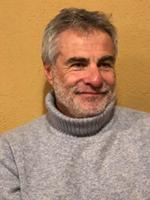Zaza Antonio
Full Professor of Physiology

room 3011, building U3, tel. +39 02 6448 3307
lab 3015, building U3, tel. +39 02 6448 3331
see also: ResearchGate
Cardiac Cell Physiology Lab (Biomedicine area)
Keywords
ion channels, excitation-contraction coupling, repolarization, arrhythmias
Background
Degree: Medicine/Cardiology; Research Assistant: Pharmacology, Columbia University (NY) (1986-1989); Professor of Physiology Univ Milano Bicocca (2000-); Hein Wellens Visiting Professor ; CARIM - Maastricht University (NL)(2017-2018). Fellow of the European Society of Cardiology (2015-) ; ESC Task-Force member (2019); Deputy Editor of Europace (2016-); Associate Editor of Frontiers (2018-) and J Cardiovasc Pharmacology (2010-).
Research interest
interaction between membrane electrophysiology and intracellular Ca2+ dynamics in arrhythmogenesis
Research areas
Cardiac electrophysiology, arrhythmias, heart failure
Research projects
-Understanding and targeting Ca2+-dependent dysfunctions to modulate cardiac structural and functional remodeling in Arrhythmogenic Cardiomyopathy (CATCHY)
Anno: 2024
Bando: FAQC 2024 - prima finestra
Enti finanziatori: Università degli Studi di MILANO-BICOCCA
-PNRR per la Missione 4, componente 2 Investimento 1.1- Avviso 104/2022 | Non-ablative radiotherapy in cardiac arrhythmias: a new paradigm beyond scar induction
Anno: 2022
Bando: Bando PRIN 2022
Enti finanziatori: MINISTERO DELL'UNIVERSITA' E DELLA RICERCA (MUR)
Selected articles
-Lee, Y. K., Sala, L., Mura, M., Rocchetti, M., Pedrazzini, M., Ran, X., . . . Gnecchi, M. (2020). MTMR4 SNVs modulate ion channel degradation and clinical severity in congenital long QT syndrome: insights in the mechanism of action of protective modifier genes. Cardiovasc Res. doi:10.1093/cvr/cvaa019
-Ronchi, C., Bernardi, J., Mura, M., Stefanello, M., Badone, B., Rocchetti, M., . . . Zaza, A. (2020). NOS1AP polymorphisms reduce NOS1 activity and interact with prolonged repolarization in arrhythmogenesis. Cardiovasc Res. doi:10.1093/cvr/cvaa036
-Brugada, J., Katritsis, D. G., Arbelo, E., Arribas, F., Bax, J. J., Blomstrom-Lundqvist, C., . . . Group, E. S. C. S. D. (2020). 2019 ESC Guidelines for the management of patients with supraventricular tachycardia; The Task Force for the management of patients with supraventricular tachycardia of the European Society of Cardiology (ESC). Eur Heart J, 41(5), 655-720. doi:10.1093/eurheartj/ehz467
-Rocchetti, M., Sala, L., Dreizehnter, L., Crotti, L., Sinnecker, D., Mura, M., . . . Zaza, A. (2017). Elucidating arrhythmogenic mechanisms of long-QT syndrome CALM1-F142L mutation in patient-specific induced pluripotent stem cell-derived cardiomyocytes. Cardiovasc Res, 113(5), 531-541. doi:10.1093/cvr/cvx006
International and national collaborations
Dipartimento BTBS - Joint Lab initiative for the development of SERCA activators (Francesco Peri, Marcella Rocchetti, Mara Ferrandi, Paolo Barassi)
Peter J Schwartz- Lia Crotti: Center for Arrhythmias of Genetic Origin - Istituto Auxologico Italiano & Università Milano-Bicocca
Massimiliano Gnecchi - Dept of Molecular Medicine – Università di Pavia
Thomas Heschenhagen – Arne Hansen: Pharmacology & Toxicology- Eppendorf University, Hamburg (DE)
Rudolph De Boer: Experimental Cardiology, Thorax center; UMCG- Groningen (NL)
Toon Van Veen-Jeroen Bakkers: Medical Physiology, University Medical Center, Utrecht (NL)
Zaza’s Lab – #ZazaLab_BtBs
last update: April 2025